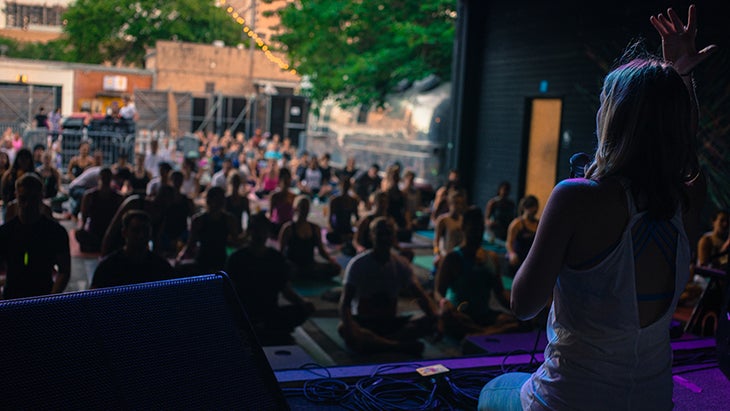Heading out the door? Read this article on the new Outside+ app available now on iOS devices for members! Download the app.

Whether you’ve practiced for years or just found yoga recently, there are a few things to think about before you start teaching yoga.
In a few weeks—or, occasionally, in just a weekend—you can be certified by a yoga school and start on your way to leading students through asanas and breathwork. Each school has its own idea of what’s necessary to help you transform from yoga student to instructor, and the Yoga Alliance has a set of standards that many studios follow when they screen teaching aspirants. Log in enough hours at registered training schools, and you’ll earn the title of Registered Yoga Teacher.
But though your hours of workshops and teacher studies will look good on a resume, it’s tough to use such statistics to measure what kind of teacher you’ll be. How much training do you really need to lead a safe and complete yoga class? And how much ongoing study is necessary to keep you growing in your own practice and in your teaching, so that your students get the best possible experience?
Many devoted yogis will tell you that determining when you’re ready to teach is a personal decision, an ethical matter as important as any other you may face in your teaching career. So how do you know when it’s time to lead?
See alsoA Yogi’s Guide to Evaluating Teacher Training Programs
1. Practice, Practice, Practice
Since most of us need to make a living somehow, it may seem tempting for the athletically inclined to add yoga teaching to their repertoire. But just slapping a yoga teacher training on your resume—after, say, Pilates, weight training, or dance—may not be enough. “You know, it’s funny, but I started out teaching this way 20 years ago,” recalls senior Anusara teacher Desiree Rumbaugh. Rumbaugh had a dance degree and had been teaching dance for 10 years when she discovered yoga. “I took a very short training course and started teaching at a community college,” she says. But she quickly discovered there was a problem with her approach: “The first week, I had 33 students. By the third week, I had three!”
Although she had a piece of paper legitimating her right to teach yoga, Rumbaugh says the experience taught her that learning yoga takes devotion—and time. “Even if we know the poses and the technique, we really don’t become powerful teachers until we understand the body and the mind and how they integrate, and that just takes years and experience. There is absolutely no shortcut.”
That doesn’t mean you must be a 30-year yoga practitioner who has studied in India and read all of the ancient yogic texts. It means that making the practice a genuine part of your life is key. How much time this takes will vary.
See alsoThe Art of Teaching Yoga: 5 Ways to Self-Assess Your Teaching Skills
2. Stay Connected to a Tradition
Sharon Gannon, cofounder of the Jivamukti Yoga School in New York, points to guiding principles passed down from yoga master T. Krishnamacharya (who taught both B.K.S. Iyengar and K. Pattabhi Jois). According to Gannon, Krishnamacharya identified three qualities that make a good teacher: connection to a lineage, dedication to the yoga sadhana, and compassion for students. In other words, Gannon adds, they should be “blessed by their own teacher, practice every day themselves, and sincerely like other people.”
Beyond that, says Gannon, ideally a teacher has gotten a taste of the yogic enlightened state of samadhi, the eighth limb of ashtanga yoga. Gannon describes this feeling of the “oneness of Being” as one in which you are “freed of the illusion of separateness.”
Now, does that mean you have to be “enlightened” or that you have to live in a constant state of samadhic elation to teach yoga? “During these times, I don’t think so,” says Gannon. “But I do think it is important to become very familiar with the teachings of the enlightened ones. This is where lineage connection comes in handy. You become a spokesperson, a channel. Humility is essential.”
That notion of humility, and of the sense that you are perhaps a single link in a long chain of yogic teachings, seems central. That’s true even if you’re working with a form of yoga that’s relatively new. The history of yoga is one of evolution, but each new branch of the practice has benefited from earlier teachings.
See alsoThe Art of Teaching Yoga: 8 Ways to Weave Philosophy Into Your Classes
3. Practice Karma Yoga
Adds Clayton Horton, an Ashtangi who runs a studio in San Francisco, it’s good to start out with the goal of offering your teaching as a service. “You have to pay your dues, perhaps volunteering, teaching friends and family,” he says. “Then it becomes really obvious to the individual whether they are ready, and whether they have enough vidya, or knowledge.”
He and other teachers emphasize that a new teacher is well served by starting out with a patient attitude—and by hanging on to other work for a while so that the yoga teaching isn’t pressured by the urgent need to make a living. This also will give you more time to begin to understand how to prevent injuries in the classroom, which can be a particular concern for students of brand-new yoga teachers.
Ultimately, keeping your own practice as a primary part of your life is essential. “A lot of people start teaching and don’t have as much time to practice,” notes Horton. But, he says, you must make the time available: “When you’re sharing something that you’re experiencing in the present moment, or maybe experienced a few days earlier in your practice, it’s much more vibrant.”